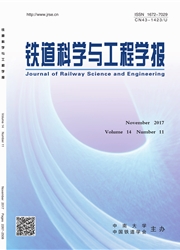

 中文摘要:
中文摘要:
离散单元法是一种特别适用于模拟不连续介质(如节理岩体)的数值方法,但实际操作起来比较困难。如何准确地模拟隧道的开挖和支护的每一个环节对计算结果的可靠性非常关键。本文以贵广铁路斗篷山隧道为工程依托,对隧道开挖、初期支护和二衬施作的全过程进行仿真分析。研究结果表明,围岩变形、初支内力、锚杆轴力等均随围岩破碎程度的提高而增加;初期支护在隧道开挖后对于围岩变形约束和承担荷载起到决定因素,二次支护仅作为永久支护结构,作为安全储备,其内力与初期支护相比较小,但考虑到开挖后围岩物理力学参数降低,岩土体流变性以及初期支护材料的力学性质减弱等原因,不应忽略其作用,应按受力结构进行计算设计。
 英文摘要:
英文摘要:
The Discrete Element Method ( DEM) is verified to be suitable for the simulation of discontinuous media(e.g., jointed rock mass) , but the actual operation is more difficult. How to accurately simulate every aspect of thetunnel excavation and support is critical for reliability of the results. Based on Doupengshan tunnel of Guiguangrailway, the whole process of tunnel excavation, i.e., primary support and secondary lining were simulated. Thestudy shows that the surrounding rock deformation, internal force of primary support, and axial force of anchor boltare improved with increasing fragmentation degrees of surrounding rock. The primary support is the determinant ofconstraint of surrounding rock deformation and bears the load after tunnel excavation. Secondary support only behavesas a permanent support structure and a safety margin, and its internal force is small as compared to that ofthe primary support. The decreasing physical and mechanical parameters of the surrounding rock excavation, rheologyof soil and reducing of mechanical properties of primary support material were taken into account . The secondarylining should be calculated and designed as force structure.
 同期刊论文项目
同期刊论文项目
 同项目期刊论文
同项目期刊论文
 期刊信息
期刊信息
